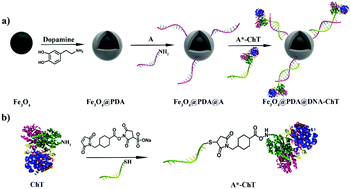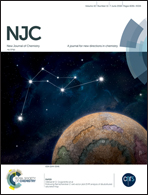Attachment of enzymes to hydrophilic magnetic nanoparticles through DNA-directed immobilization with enhanced stability and catalytic activity†
Abstract
The major barriers to the use of enzymes in practical applications are their insufficient stability and easy inactivation under processing conditions. In this work, we developed a promising platform that allows for the simple and effective immobilization of enzymes on hydrophilic polydopamine (PDA) modified magnetic nanoparticles through DNA directed immobilization. Taking α-chymotrypsin (ChT) as an example, the well-designed immobilized enzyme in this study exhibited excellent kinetic performance, and the apparent Vmax and catalytic efficiency (kcat/Km) values of the DNA immobilized enzyme were 15.77 mM min−1 mg protein−1 and 4.05 s−1 mM−1, which were more than 6.0- and 5.9-fold enhanced compared to that of the free enzyme, respectively. The DNA immobilized enzyme exhibited promising thermal stability, which could preserve promising enzymatic activities of about 83% after 60 min incubation at 60 °C. The DNA immobilized enzyme also exhibited excellent long-term storage and incubation stability, which could preserve more than 89% of the initial activity at 4 °C for 35 days and more than 77% after 47 h of incubation, respectively. In addition, the DNA immobilized ChT exhibited excellent reusability, which showed a high degree of activity (more than 84%) after 10 cycles. Notably, the enzyme immobilization procedure exhibited high reversibility and reproducibility, and the magnetic nanoparticle surfaces were successfully regenerated and cycled through DNA strand displacement reactions for subsequent enzyme immobilization, which could retrieve more than 98% of the enzymatic activity. A significantly improved protein digestion efficiency was achieved with this immobilized ChT within 10 min, and the obtained sequence coverages were more than 1.3-fold higher when compared to that obtained by conventional in-solution digestion for 12 h. Therefore, this work exhibits a promising alternative platform for the efficient immobilization of industrially important enzymes and their broad applications.



 Please wait while we load your content...
Please wait while we load your content...